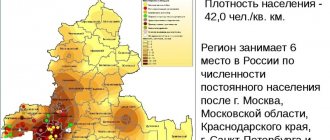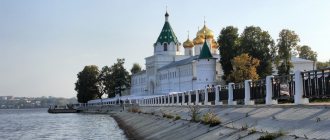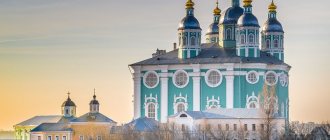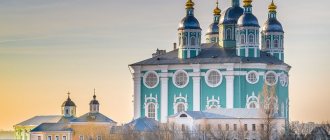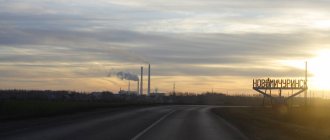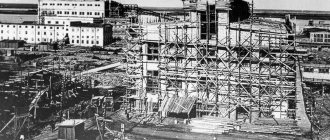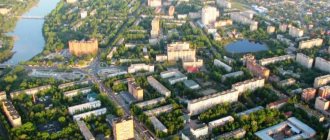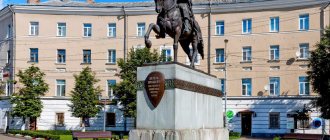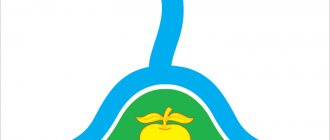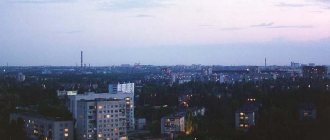Content
- 1 Millionaire cities with more than 1 million people 1.1 Nizhny Novgorod
- 2.1 Dzerzhinsk
- 3.1 Sarov
- 4.1 Navashino
Arzamas - extreme population density
Arzamas cannot be called large or large. The city's territory occupies just over 41 square meters. km. But more than 100 thousand people live on it. Surprisingly, the residents coexist peacefully, although sometimes funny incidents occur. For example, cars get stuck in traffic jams due to cows walking along the roads. Arzamas is quite small, so a lot of people leave here. Only thanks to immigrants from Central Asia is there a large increase. Moreover, it is the newcomers who contribute to the increase in the birth rate. The gypsies also try to keep up, demonstrating importunity. It gets ridiculous: cunning gypsies cordon off areas where a lot of people gather. Then they begin to voice demands for the right to use the sidewalk.
The large number led to severe deterioration of housing and communal services. Major repairs cannot be carried out in a timely manner. Inside Arzamas, traffic jams are rare, but it is difficult to leave or enter here. Public transport is functioning properly and there are enough places. Another thing is kindergartens. The townspeople of the densely populated Arzamas are accustomed to using the services of nannies, because it is very difficult to wait in line for a vacant position. Fortunately, there are enough clinics, schools are also not full of students.
The cities of the Nizhny Novgorod region face the same problems as many other Russian settlements, especially those with a population of over a million. The difficulties of Nizhny Novgorod are associated with the illiterate actions of municipalities. It’s high time for the metropolis to acquire good roads and infrastructure, but so far the situation has not changed. This means that the city will continue to face:
- lack of places in kindergartens;
- rising prices for housing;
- traffic congestion.
As usual, resolving issues depends entirely on the availability of budgetary funds, which are often insufficient.
Millionaire cities with more than 1 million people
Coat of arms of Nizhny Novgorod Flag of Nizhny Novgorod
Nizhny Novgorod
Population 1,266,871 (2016). The largest city on the Volga, the third most populous city in the European part of Russia. In the RSFSR it was the third city in terms of population and industrial potential; its population at its peak reached 1.44 million (1992). After the collapse of the USSR, the city experienced severe depopulation due to the city's proximity to Moscow. The population reached 1 million people in 1962. According to 2011-2013 data, the city ranked 29th to 32nd in the country in terms of industrial production[1].
Among other things, the city is home to the large shipbuilding plant Krasnoye Sormovo, the Nizhny Novgorod Stadium and.
Coat of arms of Dzerzhinsk
Distance from Nizhny Novgorod to Russian cities
Distances from major Russian cities to Nizhny Novgorod. Distance between Russian cities. Calculation of distances between cities may contain small errors.
Distance from Nizhny Novgorod to Abakan - 3838 km Distance from Nizhny Novgorod to Arkhangelsk - 1279 km Distance from Nizhny Novgorod to Astrakhan - 1424 km Distance from Nizhny Novgorod to Barnaul - 3165 km Distance from Nizhny Novgorod to Astrakhan Belgorod - 1083 km Distance from Nizhny Novgorod to Birobidzhan - 7808 km Distance from Nizhny Novgorod to Blagoveshchensk - 7436 km Distance from Nizhny Novgorod to Bryansk - 810 km Distance from Nizhny Novgorod to Veliky Novgorod - 945 km Distance from Nizhny Novgorod to Vladivostok - 8755 km Distance from Nizhny Novgorod to Vladikavkaz - 1823 km Distance from Nizhny Novgorod to Vladimir - 236 km Distance from Nizhny Novgorod to Volgograd - 996 km Distance from Nizhny Novgorod to Volgograd Volzhsky - 994 km Distance from Nizhny Novgorod to Vologda - 575 km Distance from Nizhny Novgorod to Voronezh - 732 km Distance from Nizhny Novgorod to Gorno-Altaisk - 3390 km Distance from Nizhny Novgorod to Grozny - 1813 km Distance from Nizhny Novgorod to Yekaterinburg - 1336 km Distance from Nizhny Novgorod to Ivanovo - 243 km Distance from Nizhny Novgorod to Izhevsk - 790 km Distance from Nizhny Novgorod to Irkutsk - 4785 km Distance from Nizhny Novgorod to Yoshkar-Ola - 338 km Distance from Nizhny Novgorod to Kazan - 397 km Distance from Nizhny Novgorod to Kaliningrad - 1674 km Distance from Nizhny Novgorod to Kaluga - 614 km Distance from Nizhny Novgorod to Kemerovo - 3198 km Distance from Nizhny Novgorod to Kirov - 605 km Distance from Nizhny Novgorod to Kostroma - 350 km Distance from Nizhny Novgorod to Krasnodar - 1568 km Distance from Nizhny Novgorod to Krasnoyarsk - 3731 km Distance from Nizhny Novgorod to Kurgan - 1639 km Distance from Nizhny Novgorod to Kursk - 935 km Distance from Nizhny Novgorod to Kyzyl - 4240 km Distance from Nizhny Novgorod to Lipetsk - 604 km Distance from Nizhny Novgorod to Magadan - 9592 km Distance from Nizhny Novgorod to Magas - 1814 km Distance from Nizhny Novgorod to Magnitogorsk - 1276 km Distance from Nizhny Novgorod to Makhachkala - 1860 km Distance from Nizhny Novgorod to Moscow - 416 km Distance from Nizhny Novgorod to Murmansk - 1972 km Distance from Nizhny Novgorod to Naberezhnye Chelny - 639 km Distance from Nizhny Novgorod to Nalchik - 1778 km Distance from Nizhny Novgorod to Nizhny Tagil - 1461 km Distance from Nizhny Novgorod to Novokuznetsk - 3322 km Distance from Nizhny Novgorod to Novosibirsk - 2941 km Distance from Nizhny Novgorod to Omsk - 2287 km Distance from Nizhny Novgorod to Orel - 780 km Distance from Nizhny Novgorod to Orenburg - 1174 km Distance from Nizhny Novgorod to Penza - 431 km Distance from Nizhny Novgorod to Perm - 1078 km Distance from Nizhny Novgorod to Petrozavodsk - 1178 km Distance from Nizhny Novgorod to Pskov - 1161 km Distance from Nizhny Novgorod to Rostov-on -Don — 1292 km Distance from Nizhny Novgorod to Ryazan — 425 km Distance from Nizhny Novgorod to Samara — 738 km Distance from Nizhny Novgorod to St. Petersburg — 1129 km Distance from Nizhny Novgorod to Saransk — 289 km Distance from Nizhny Novgorod to Saratov - 638 km Distance from Nizhny Novgorod to Smolensk - 829 km Distance from Nizhny Novgorod to Sochi - 1806 km Distance from Nizhny Novgorod to Stavropol - 1564 km Distance from Nizhny Novgorod to Sterlitamak - 1061 km Distance from Nizhny Novgorod to Surgut - 2467 km Distance from Nizhny Novgorod to Syktyvkar - 963 km Distance from Nizhny Novgorod to Tambov - 559 km Distance from Nizhny Novgorod to Tver - 584 km Distance from Nizhny Novgorod to Tolyatti - 661 km Distance from Nizhny Novgorod to Tomsk - 3201 km Distance from Nizhny Novgorod to Tula - 595 km Distance from Nizhny Novgorod to Tyumen - 1665 km Distance from Nizhny Novgorod to Tula Ulan-Ude - 5223 km Distance from Nizhny Novgorod to Ulyanovsk - 444 km Distance from Nizhny Novgorod to Ufa - 927 km Distance from Nizhny Novgorod to Khabarovsk - 7990 km Distance from Nizhny Novgorod to Khanty-Mansiysk — 2256 km Distance from Nizhny Novgorod to Cheboksary — 244 km Distance from Nizhny Novgorod to Chelyabinsk — 1354 km Distance from Nizhny Novgorod to Cherepovets — 636 km Distance from Nizhny Novgorod to Cherkessk — 1680 km Distance from Nizhny Novgorod to Chita - 5875 km Distance from Nizhny Novgorod to Elista - 1292 km Distance from Nizhny Novgorod to Yuzhno-Sakhalinsk - 8898 km Distance from Nizhny Novgorod to Yakutsk - 7954 km Distance from Nizhny Novgorod to Yakutsk Yaroslavl – 371 km
| Distance from Moscow | Distance from Volgograd | Distance from Ekaterinburg |
| Distance from Kazan | Distance from Nizhny Novgorod | Distance from Novosibirsk |
| Distance from Omsk | Distance from Rostov-on-Don | Distance from Samara |
| Distance from St. Petersburg | Distance from Ufa | Distance from Chelyabinsk |
Check out other popular maps of countries around the world:
| Map of Russia | Map of Italy | Germany map | Israel Map |
| Map of Spain | Turkey Map | USA map | Armenia Map |
| Poland map | Greece map | Bulgaria Map | Czech Republic Map |
| Kazakhstan map | China map | UK map | Switzerland map |
WORLD MAP |
MAP OF AMERICA | MAP OF AFRICA | MAP OF CRIMEA | MAP OF EURASIA 2022 © BigKarta.ru
Medium-sized cities 20-100 thousand people
Sarov
Population 94,417 people (2016). Closed city.
Bor
Population 78,385 (2017). A satellite city of Nizhny Novgorod, located opposite it across the Volga River.
Kstovo
Population 67,305 people (2016).
Pavlovo
Population 58,423 people (2016).
Vyksa
Population 53,477 people (2016).
Balakhna
Population 49,626 people (2016).
Trans-Volga region
Population 38,906 people (2016).
Bogorodsk
Population 34,597 people (2016).
Kulebaki
Population 33,280 people (2016).
Gorodets
Population 30,530 people (2016).
Semyonov
Population 24,583 (2016).
Lyskovo
Population 21,308 people (2016).
Sergach
Population 20,370 people (2016).
Shakhunya
Population 20,217 people (2016).
Small towns up to 20 thousand people
Navashino
Population 15,281 people (2016).
In the city on the banks of the Navashinsky backwater of the Oka River, among other things, the Okskaya Shipyard is located - a manufacturer of small and medium-sized ships, as well as pontoon parks, which is a city-forming enterprise.
Despite formally belonging to another region, Navashino is actually a satellite town of Murom beyond the Oka.
Lukoyanov
Population 14,243 people (2016).
Pervomaisk
Population 13,706 people (2016).
Uren
Population 12,257 people (2016).
Chkalovsk
Population 11,601 people (2016).
Vorsma
Population 10,630 people (2016).
Volodarsk
Population 10,084 people (2016).
Transportation
Population 9,041 people (2016).
Vetluga
Population 8,470 people (2016).
Knyaginino
Population 7,092 people (2016).
Gorbatov
Population 2,004 people (2016).
Map
| Nizhny Novgorod: maps |
Nizhny Novgorod: photo from space (Google Maps) Nizhny Novgorod: photo from space (Microsoft Virtual Earth)
| Nizhny Novgorod. Nearest cities. Distances in km. on the map (in brackets along roads) + direction. Using the hyperlink in the distance , you can get the route (information courtesy of the AutoTransInfo website) | |||
| 1 | Bor | 5 (26) | NE |
| 2 | Zhdanovsky | 13 () | SE |
| 3 | Bolshoye Kozino | 19 (23) | NW |
| 4 | Kstovo | 22 (32) | SE |
| 5 | Balakhna | 31 (37) | NW |
| 6 | Hydropeat | 33 () | NW |
| 7 | Linda | 33 (47) | WITH |
| 8 | Dzerzhinsk | 35 (35) | Z |
| 9 | Bogorodsk | 38 (49) | SW |
| 10 | Reshetikha | 45 (45) | Z |
| 11 | Gorodets | 48 (53) | NW |
| 12 | Volodarsk | 50 (51) | Z |
| 13 | Trans-Volga region | 50 (60) | NW |
| 14 | Far Konstantinovo | 56 (77) | YU |
| 15 | Vorsma | 58 (69) | SW |
| 16 | Novosmolinsky | 59 () | Z |
| 17 | Semyonov | 61 (86) | NE |
| 18 | Gorbatov | 61 (93) | Z |
| 19 | Ilyinogorsk | 63 (67) | Z |
| 20 | Mulino | 64 () | IN |
| 21 | Chkalovsk | 67 (99) | NW |
| 22 | Pavlovo | 70 (82) | SW |
| 23 | Tumbotino | 70 (89) | SW |
| 24 | Lyskovo | 71 (95) | SE |
| 25 | Bolshoye Murashkino | 76 (94) | SE |
| 26 | Sosnovskoe | 77 (99) | SW |
| 27 | Gorokhovets | 81 (87) | Z |
| 28 | Knyaginino | 84 (111) | SE |
| 29 | Transportation | 86 (126) | SE |
| 30 | In hell | 88 (106) | YU |
a brief description of
Located at the confluence of the Oka and Volga rivers, 439 km east of Moscow. Large railway node: 6 railway lines beams (3 main ones). River port. Metropolitan (since 1985).
The climate is moderate continental. The average temperature in January is about -12C, in July about +18C. Precipitation is 500 mm per year.
25 km from Nizhny Novgorod, within its suburban area, is the balneoclimatic resort area of Green City.
Territory (sq. km): 411
Information about the city of Nizhny Novgorod on the Russian Wikipedia site
Historical sketch
Founded in 1221 by the Vladimir prince Yuri Vsevolodovich as a fortress called Novgorod, which perhaps meant not just “new city”, but repeated the name of the city Novgorod, which is on the Volkhov River.
To distinguish between cities of the same name, the definition lower is introduced, which was first used sporadically, and from the 14th century. almost constantly now. This definition is most often understood as indicating the location of the city in the lower lands, on the Lower Ground. But, according to a number of authors, in this case the city would be called not Nizhny, but Nizovsky Novgorod. In addition, attention is drawn to the fact that pairs of names with the definition lower and upper usually appear within the same river, which is confirmed by many examples, i.e. the city in relation to which Novgorod is lower must be located above it on the Oka or Volga. Such a city could be Gorodets, which arose earlier than Novgorod, lies upstream of the Volga, and it was from it that the functions of an advanced defensive point passed to Novgorod. There is also indirect evidence that Gorodets was originally called the City, and, therefore, it could be contrasted with the New City, also known as the Lower City, hence the name of the inhabitants of Nizhny Novgorod.
Since 1350, the capital of the Nizhny Novgorod-Suzdal principality created in 1341. Thanks to its favorable geographical location, Nizhny Novgorod has acquired the significance of a major trade and cultural center.
Initially, the city was surrounded by oak walls; in 1372, construction of a stone Kremlin began.
In 1392, under Vasily I, Nizhny Novgorod was annexed to the Moscow Principality and soon became a stronghold of Rus' in the fight against the Kazan Khanate. In 1506-11 under Vasily III, a new brick Kremlin was built. The fortress allowed the Nizhny Novgorod residents to repel the raids of the Tatars in 1520 and 1536.
From the second half of the 16th century. one of the largest trade and craft centers of the Moscow State. At this time, two parts of the city took shape: Nagornaya (the center) and Zarechnaya (later the industrial area).
Nizhny Novgorod played an important role in preserving the country during the Time of Troubles. In 1611-12 in Nizhny Novgorod, the militia of the zemstvo elder Kuzma Minin and Prince D.M. was formed. Pozharsky against the Polish interventionists.
In 1708 he was assigned to the Kazan province. In 1714-17 center of the Nizhny Novgorod province, in 1717-19. again in the Kazan province. Since 1719, the center of the newly formed Nizhny Novgorod province. Since 1779, the center of the Nizhny Novgorod governorship (since 1796 - the Nizhny Novgorod province).
In the 19th century, the flour-milling industry and production related to Volga shipping were developed. In 1817, the Makaryevskaya Fair was transferred to Nizhny Novgorod. In 1849, the Sormovo shipbuilding plant was launched. In 1862, Nizhny Novgorod was connected by railway to Moscow.
In 1856, in the provincial city of Nizhny Novgorod, Nizhny Novgorod province, there were 49 churches, 2,555 houses, 550 shops.
From the middle of the 19th century. The Volga shipping company is developing especially intensively.
Since 1929, Nizhny Novgorod has been a regional center. In 1932, it was renamed Gorky in honor of the writer Maxim Gorky (A.M. Peshkov; 1868-1936), a native of this city.
In 1928, the cities of Sormovo (6.3 thousand inhabitants, 1897; city since 1925) and Kanavino (formed in 1925) were included within the boundaries of Nizhny Novgorod.
In 1991, the city returned its historical name.
In 2022, the urban district included 7 settlements of the Bogorodsky municipal district.
Municipal indicators
| Index | 1990 | 1999 | 2001 | 2003 | 2005 |
| Demography | |||||
| Number of births, per 1000 population | 10.7 | 7 | 7.5 | 8.9 | 8.8 |
| Number of deaths, per 1000 population | 11.4 | 14.9 | 16.3 | 18 | 17.5 |
| Natural increase (decrease), per 1000 population | -0.7 | -7.9 | -8.8 | -9.1 | -8.7 |
| Standard of living of the population and social sphere | |||||
| Average monthly nominal accrued wages, rub. | 1193.4 | 2495.2 | 5078.1 | 8078.6 | |
| Average housing area per inhabitant (at the end of the year), sq.m. | 15.6 | 18.4 | 18.9 | 19.8 | 20.3 |
| Number of preschool institutions, pcs. | 513 | 358 | 345 | 334 | 330 |
| Number of children in preschool institutions, thousand people | 82.3 | 44.1 | 43.2 | 43.3 | 44.3 |
| Enrollment of children in preschool educational institutions (at the end of the year), as a percentage of the number of children of the corresponding age, % | 74 | 73.2 | |||
| Number of daytime educational institutions (at the beginning of the school year), pcs. | 178 | 193 | 191 | 196 | 194 |
| Number of students in daytime educational institutions, thousand people | 157.8 | 165.3 | 152.9 | 137.1 | 119.8 |
| Number of doctors, people. | 10289 | 9867 | 9636 | 9637 | 9693 |
| Number of nursing staff, people. | 18883 | 16656 | 15581 | 15469 | 15474 |
| Number of hospital institutions, pcs. | 65 | 72 | 69 | 71 | 70 |
| Number of hospital beds, thousand units | 22.3 | 20.9 | 20 | 18.9 | 19.7 |
| Number of medical outpatient clinics, pcs. | 166 | 183 | 189 | 243 | |
| Capacity of medical outpatient clinics, visits per shift, thousand units. | 27.1 | 25.8 | 29.1 | 29.3 | 30 |
| Number of registered crimes, pcs. | 25952 | 29994 | 28612 | 51409 | |
| Persons who committed crimes were identified, persons. | 13087 | 12492 | 7426 | 8426 | |
| Economy, industry | |||||
| Number of enterprises and organizations (at the end of the year), pcs. | 37103 | 48590 | 108453 | 80374 | |
| Number of operating enterprises by type of activity: mining (at the end of the year), pcs. | 3 | ||||
| Number of operating enterprises by type of activity: manufacturing (at the end of the year), pcs. | 473 | ||||
| Number of operating enterprises by type of activity production and distribution of electricity, gas and water (at the end of the year), pcs. | 116 | ||||
| Volume of shipped goods of own production by type of mining (in actual prices), million rubles. | 16.4 | ||||
| Volume of shipped goods of own production by type of manufacturing (in actual prices), million rubles. | 106518.6 | ||||
| Volume of shipped goods of own production by type of production and distribution of electricity, gas and water (in actual current prices), million rubles. | 22619 | ||||
| Construction | |||||
| Volume of work performed by type of activity “Construction” (until 2004 - volume of work performed under construction contracts), million rubles. | 1461.9 | 3608.5 | 5154.8 | 9348.7 | |
| Commissioning of residential buildings, thousand sq.m. of total area | 500 | 236.1 | 231.3 | 261.3 | 361.7 |
| Commissioning of residential buildings, apartments | 3369 | 2743 | 3459 | 4850 | |
| Commissioning of preschool institutions, places | 2150 | 0 | 0 | 0 | 0 |
| Commissioning of educational institutions, places | 1596 | 0 | 0 | 250 | 525 |
| Commissioning of hospital facilities, beds | 270 | 0 | 0 | 0 | 17 |
| Commissioning of outpatient clinics, visits per shift | 425 | 50 | 0 | 400 | 270 |
| Transport | |||||
| Number of metro stations, pcs. | 13 | 13 | |||
| Operating length of metro tracks, km | 11 | 14 | 15 | ||
| Number of bus routes (in intracity traffic), pcs. | 124 | 190 | 206 | 156 | |
| Number of tram routes, pcs. | 20 | 20 | 21 | 18 | |
| Length of operational tram tracks (at the end of the year), km | 86.5 | 90.2 | 90.2 | ||
| Number of trolleybus routes, pcs. | 20 | 21 | 23 | 23 | |
| Length of operational trolleybus lines (at the end of the year), km | 102.2 | 118.7 | 123.7 | ||
| Number of passengers transported by metro per year, million people. | 60 | 50 | 48.3 | 32.5 | |
| Number of passengers transported by buses per year (in intracity traffic), million people. | 460.5 | 499.6 | 440.5 | 401 | 473 |
| Number of passengers transported by trams per year, million people. | 140.7 | 208.4 | 253.1 | 283.8 | 129 |
| Number of passengers transported by trolleybuses per year, million people. | 64 | 170.8 | 201.1 | 228.1 | 97.9 |
| Connection | |||||
| Number of telephone sets of the city public telephone network, thousand units. | 241.1 | 417.5 | 435.7 | 462.9 | 482.7 |
| Number of residential telephone sets of the city public telephone network, thousand units. | 173.6 | 333 | 358.2 | 388.6 | 402.7 |
| Number of payphones of the city telephone network (including universal ones), pcs. | 2166 | 2456 | |||
| Trade and services to the population | |||||
| Retail trade turnover (in actual prices), million rubles. | 18181.7 | 32782.5 | 61060.7 | 96686.4 | |
| Retail trade turnover (in actual prices), per capita, rub. | 10450 | 24350 | 46568.6 | 74691 | |
| Index of physical volume of retail trade turnover, % compared to the previous year | 111.6 | 110.1 | |||
| Index of physical volume of public catering turnover, % compared to the previous year | 80.5 | 108.8 | |||
| Number of stores, pavilions (at the end of the year), pcs. | 334 | 756 | |||
| Sales area of shops, pavilions (at the end of the year), sq.m. | 88692.5 | 123267.7 | |||
| Volume of paid services to the population (in actual prices), million rubles. | 3935.8 | 7130.7 | 11579.9 | 18486.5 | |
| Volume of paid services to the population (in actual prices), per capita, rub. | 2871 | 5329.4 | 8831.5 | 14281 | |
| Volume of household services to the population (in actual prices), million rubles. | 0.093 | 642.5 | 826.5 | 868.1 | 1336.7 |
| Volume of household services to the population (in actual prices), per capita, rub. | 0.065 | 469 | 618 | 662 | 1032.6 |
| Investments | |||||
| Investments in fixed assets (in actual prices), million rubles. | 1 | 4536.1 | 5124.5 | 9521 | 17063.3 |
| Share of investments in fixed assets financed from budgetary funds in the total volume of investments, % | 8.8 | 19.8 | 18.7 | 14 | |
Data sources:
- Regions of Russia. Main characteristics of the constituent entities of the Russian Federation: statistical collection. Goskomstat of Russia. - M:, 2003.
- Regions of Russia. Basic socio-economic indicators of cities. Statistical collection. Rosstat. - M:, 2005. p. 231
- Transport in Russia: Statistical collection. Goskomstat. - M:, 2003. pp. 110, 112, 114, 120, 122, 123
- Transport in Russia: Statistical collection. Rosstat. - M:, 2005. pp. 117, 119, 121, 127, 129
- Regions of Russia. Basic socio-economic indicators of cities. 2006. Statistical collection. Rosstat. - M:, 2006. p. 235
Culture, science, education
University and technical university. Medical Academy.
Institutes: architectural and construction, pedagogical, water transport engineers, agricultural.
Faculty of Moscow Commercial University. Branches of the All-Russian correspondence institutes: financial and economic, railway engineers. transport.
Conservatory.
Theatres: drama, opera and ballet, young spectators, comedy, puppets.
Museums: Historical and Architectural Museum-Reserve (founded in 1896), art, folk art crafts, architecture and life of the peoples of the Nizhny Novgorod Volga region, river fleet, M. Gorky (with branches “Kashirin’s House” and “M. Gorky’s Last Apartment in Nizhny Novgorod"). House-museums: the Nevzorov sisters, Ya.M. Sverdlova.
Nizhny Novgorod is the birthplace of mechanic I.P. Kulibina, mathematician N.I. Lobachevsky, literary critic N.A. Dobrolyubov, composer M.A. Balakirev, writer P.I. Pechersky.
Architecture, sights
In the 17th century The upland part of the city consisted of the City (i.e. the Kremlin), the surrounding Upper (to the south) and Lower (under the high bank) suburbs and settlements scattered across the neighboring hills.
Architectural monuments of the 16th - early 18th centuries: the Kremlin (fortress walls with towers - 1500, 1508-11) with the Archangel Cathedral (1624-31, L. and A. Vozoulin, on the site of the old 13th century cathedral). Monasteries - Annunciation with the cathedral (1649) and the Assumption Church (1678); Pechersky with the Ascension Cathedral (1632, A. Vozoulin) and 2 tent churches (1642-45 and 1648).
Assumption Church on Ilyinskaya Hill (1672-1715), “Stroganov style” churches - Smolenskaya (1694-97) and Rozhdestvenskaya (1719). Pushnikov's house (17th century).
Since 1770, the Nagorny part of Nizhny Novgorod began to be built up according to a regular plan with buildings in the style of classicism (former Assembly of the Nobility, 1826). Architecture of the late 19th - early 20th centuries: drama theater (1896, architect V.A. Schröter), State Bank (1913, architect V.A. Pokrovsky), Sirotkin House (1913, architects Vesnin brothers; now the Art Museum).
In the 1930s The House of Soviets was built (architect A.Z. Grinberg). In 1964 - circus, river and railway. train stations (1965, reconstruction), air terminal, sports complex, etc.
| Population by year (thousands of inhabitants) | |||||||
| 1811 | 14.4 | 1956 | 876 | 1996 | 1385.9 | 2013 | 1259.9 |
| 1840 | 31.9 | 1959 | 942.0 | 1998 | 1367.7 | 2014 | 1263.9 |
| 1856 | 35.8 | 1962 | 1025 | 2000 | 1357.0 | 2015 | 1267.8 |
| 1863 | 41.5 | 1967 | 1120 | 2001 | 1346.7 | 2016 | 1266.9 |
| 1897 | 90.1 | 1970 | 1170.3 | 2003 | 1311.3 | 2017 | 1261.7 |
| 1913 | 111.4 | 1973 | 1238 | 2005 | 1289.5 | 2018 | 1259.0 |
| 1914 | 111.6 | 1976 | 1305 | 2006 | 1283.6 | 2019 | 1253.5 |
| 1923 | 135.4 | 1979 | 1344.5 | 2007 | 1278.3 | 2020 | 1252.2 |
| 1926 | 217.1 | 1982 | 1373 | 2008 | 1274.7 | 2021 | 1244.3 |
| 1931 | 350.3 | 1986 | 1409 | 2010 | 1271.0 | ||
| 1934 | 463.5 | 1989 | 1438.1 | 2011 | 1250.6 | ||
| 1939 | 643.7 | 1992 | 1440.6 | 2012 | 1254.6 | ||
see also
- Nizhny Novgorod Region
- Cities of Russia
| [ + ] Cities by regions of Russia | |
| Cities of the North-West (NWFD) | St. Petersburg (and its cities) • Leningrad region (historical Staraya Ladoga) • Arkhangelsk region • Vologda region • Kaliningrad region • Karelia • Komi • Murmansk region • Nenets Autonomous Okrug • Pskov region |
| Cities of the Volga region (Volga Federal District) | Bashkortostan • Volgograd region • Kalmykia • Kirov region • Mari El • Mordovia • Nizhny Novgorod region • Orenburg region • Penza region • Perm region • Samara region • Saratov region • Tatarstan • Udmurtia • Ulyanovsk region • Chuvashia |
| Cities of Southern Russia (SFD) | Sevastopol (including Inkerman) • Republic of Crimea • Adygea • Astrakhan region • Krasnodar region • Rostov region |
| Cities of the North Caucasus (NCFD) | Dagestan • Ingushetia • Kabardino-Balkaria • Karachay-Cherkessia • North Ossetia - Alania • Stavropol Territory • Chechen Republic |
| Cities of the Urals (Ural Federal District) | Kurgan region • Sverdlovsk region • Tyumen region • Khanty-Mansi Autonomous Okrug - Yugra • Chelyabinsk region • Yamalo-Nenets Autonomous Okrug |
| Cities of Siberia (Siberian Federal District) | Altai Republic • Altai Territory • Irkutsk Region • Kemerovo Region • Krasnoyarsk Region • Novgorod Region • Novosibirsk Region • Omsk Region • Tomsk Region • Tyva • Khakassia |
| Cities of the Far East (FEFD) | Amur Region • Buryatia • Jewish Autonomous Region • Trans-Baikal Territory • Kamchatka Territory • Magadan Region • Primorsky Territory • Sakha (Yakutia) • Sakhalin Region • Khabarovsk Territory • Chukotka Autonomous Region |
| see also | Cities of the DPR, LPR, Transnistria, South Ossetia • Regions of Russia • Cities of Russia |
General information about the Nizhny Novgorod region
Distinctive features .
The Nizhny Novgorod region is one of the most economically developed subjects of the Russian Federation in the Volga Federal District. True, it is still unclear whether dividing the country into federal districts will take root in the popular consciousness. It is more common for Russians to divide Russia into Siberia, the Far East, the Caucasus and the Center. The North stands apart, where few people have been, as well as in those distant cities and towns from where a new day begins all over the planet. But if we move west from the Ural Mountains, then this territory will form the foundation of our huge country, albeit not in terms of mineral resources, but definitely in terms of specific population size and level of socio-economic development. However, even here you will not find as much prosperity as you would expect at first glance: in addition to Moscow and St. Petersburg, life is bustling only around 3-5 large cities that make up the “semantic core” of Russia.
And one of these centers with deep historical roots is Nizhny Novgorod. Since ancient times, this ancient Russian city was the trading core of the Russian state, and merchants from all over Rus' flocked to the famous Nizhny Novgorod fairs. And modern Nizhny has not lost its former influence, transforming over time into the largest industrial center of Russia.
The main building of the Nizhny Novgorod Fair - an international exhibition complex
As you know, a region directly depends on the state of affairs in its center. Therefore, the Nizhny Novgorod region, having neither particularly fertile soils nor mineral reserves (it is known that the subsoil is our everything), is nevertheless a leader in many economic indicators, from average monthly income per capita (27th place in Russia ) to the total area of residential premises per resident (33rd place).
Today, the administrative center of the Nizhny Novgorod region is the fifth largest city in Russia with a population of 1.26 million people. In addition to Nizhny Novgorod, the homeland of Gazelles, armored personnel carriers and Ryaba mayonnaise, large regional cities that are popular throughout the country are of great importance for the development of the region (what is it, the whole of Russia!): Dzerzhinsk - for antifreeze, Bor - for automobile glass, Sarov, better known as Arzamas-16, for secret facilities for the development of nuclear weapons.
This is what distinguishes the Nizhny Novgorod region from many central Russian provinces: most regional centers are full-fledged cities, quite suitable for modern civilized life.
Geographical location . What about the neighbors? In the north, the Nizhny Novgorod lands, which are part of the Volga Federal District, border with the Kostroma and Ivanovo regions, which close the TOP 100 most successful regions of Russia (particularly vigilant ones have already considered that there are only 83 subjects of the Russian Federation in the country:) The situation is slightly better with other northern neighbors - Vladimir and Kirov regions, but they are clearly far from the industrial power of Nizhny Novgorod...
And in the south, the Nizhny Novgorod region was surrounded by the territories of fraternal peoples, proudly called republics: Mordovia, Chuvashia and Mari El. There is no need to talk about any economic achievements at all: the people live there more than modestly, but independently.
At the same time, the Nizhny Novgorod region is rich in deciduous and coniferous forests, which occupy more than half of its territory. There are also more than 9 thousand small rivers in the region. Which, unlike large and heavily polluted waterways - the Volga, Oka and Vetluga - are quite clean.
Kerzhenets River. Photo by Alex (https://fotki.yandex.ru/users/melnik-kursk/)
Incredibly beautiful corners of natural nature, rich in the full range of forest gifts, are not only an outlet and source of food for many Nizhny Novgorod residents. It is also a reliable environmental barrier that effectively neutralizes all the results of man-made impacts on the environment.
Population. The Nizhny Novgorod region is one of the few sources of opportunities for seekers of a better life in the vastness of the European part of Russia. Especially if fate has endowed these seekers with Slavic roots: then you will obviously not be so welcome in many “tasty” corners... say, in Tatarstan, where the standard of living is much higher, but from Russia only federal laws remain, and even then more to preserve status -quo.
Today the population of the region is 3,289,841 people. 79% of them live in cities. Previously (during the period of perestroika) the population of the region was even higher - 3.7 million people. But in the turbulent 90s, the natural population decline began to grow at a crazy pace. Now the situation has become better, but still the natural decline is 4.2 people. per thousand population.
By national composition, 93.93% of the region's population are Russians. Other nationalities are practically not represented (each of them makes up less than 1% of the region's population). After the Russians, Tatars have the largest share - 1.33%. 0.58% and 0.53% are Mordovians and Ukrainians, respectively.
Crime . In the criminal ranking by the number of crimes committed, the Nizhny Novgorod region ranks 18th. And it is not surprising that one of the most economically developed regions has such a high rate. Where there is money, there is crime. However, it is worth noting the fact that of all the European regions of Russia, one of the highest crime rates is noted here (higher only in the Perm Territory).
Unemployment rate. The Nizhny Novgorod region has impressive industrial potential, inherited from the Soviet economy. Therefore, the art of managing a region fades into the background, and the main task of the region’s leadership is to preserve what it already has.
The leading industries in the Nizhny Novgorod region are mechanical engineering and chemicals. The region is home to one of the largest hydroelectric power stations in Russia, the Nizhny Novgorod hydroelectric power station.
Nizhny Novgorod hydroelectric power station. Photo by mitja-32 (https://fotki.yandex.ru/users/mitja-32/)
According to statistics for 2012, the unemployment rate in the Nizhny Novgorod region was 5.4% (31st place in the ranking of regions). The average salary in the region is 20,467 rubles. But this is the “average level for the hospital.” In some sectors, people's incomes are negligible. For example, in the fishing industry - only 8 thousand rubles. And the highest salaries (about 40 thousand rubles) are in the field of finance, production of petroleum products and nuclear materials and, oddly enough, in the field of scientific development.
Property value. The average cost of housing in the Nizhny Novgorod region is 66,344 rubles per sq. m. meter. But in Nizhny Novgorod prices are higher. So, to buy a one-room apartment there, you need to have 2 - 2.5 million rubles. Prices for two-room apartments start from 2.5 million rubles, three-room apartments - from 3 million rubles.
The climate of the Nizhny Novgorod region is temperate continental. In January the average temperature is −12°C. Summer is relatively short; in July the average temperature is +19°C. But there are often cases when you can see very extreme values on the thermometer, like +39°C in summer or −44°C in winter. The average annual precipitation is 600 mm per year. Droughts are frequent in the southeast of the Right Bank.
